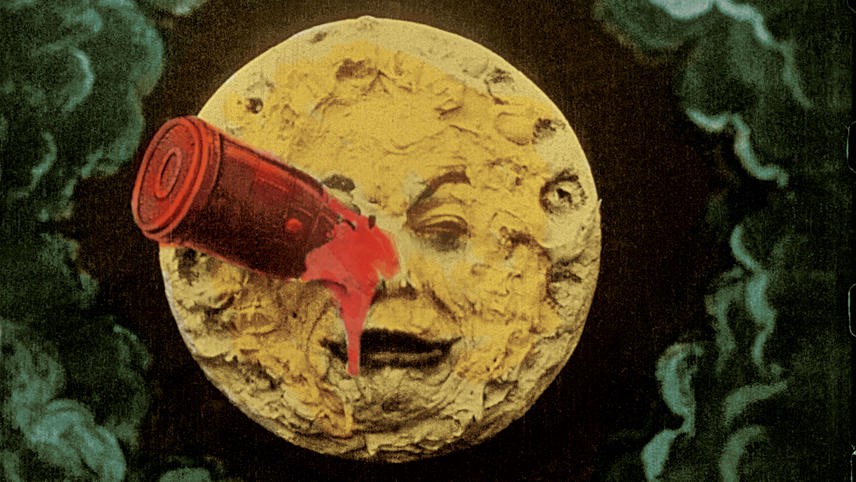
- Industry
The Early Years of Color in Films – Painted by Women
Early filmmakers gravitated in the direction of subjects that seemed to defy nature: convoluted acrobatic routines, superhuman displays of strength, magic acts, fairy tales and dream films. The bold and often fantastical colors that flickered across the earliest film reels are frequently left out of our greater cinematic history. More neglected still are the women responsible for those dazzling hues.
Decades before the technicolor wonders of The Wizard of Oz (1939) and Gone with the Wind (1939), Georges Méliès, early French experimenter with motion pictures, employed 21 women at his Montreuil studio to hand-color his films frame by frame. This was the moment when the gray shadows of the silent screen burst to life with the wondrous and shocking vitality of color.
Until 1905, as filmmakers experimented with a variety of techniques for dyeing 35mm black-and-white prints, women colorists learned to paint these silent films frame by frame, with delicate brushstrokes using minuscule camelhair brushes, meticulously carved stencils, and chemical baths that washed entire scenes in icy blues, resplendent greens, or fiery reds. Almost all of these early coloring techniques were applied to films after they had already been shot. The meticulous, exhausting work of hand-coloring film was one of the first careers in film production available to artistic women. Their efforts can still be seen and appreciated thanks to the restoration and digitizing work done by archivists.
Women in film-coloring workshops peered into powerful magnifying glasses as they applied dye with brushes as fine as a single camel hair. Working on a tiny 35mm canvas required precision, particularly when an errant brushstroke could have ruined an entire frame. There was more to it than cheap labor, though. The work of coloring film was seen as a craft similar to such domestic, female-coded tasks as painting glass or china. Joshua Yumibe writes in his 2012 book Moving Color, “women historically have been assumed to be more attuned to color and more susceptible to its sensual influences.”
Yumibe explains that coloring film was similarly seen as mere ornamentation, similar to the task of applying facial cosmetics, and thus perfectly suited to women. To see late 19th-century women readily accepted into any craft is unusual. Unsurprisingly, one of the reasons they were hired was because they could be employed for less pay. One French workshop run by the Pathé brothers in the 1910s notably paid their female colorists 21 francs per week.
As colors became particularly popular in dance films. Female dance routines were a popular part of vaudeville acts and early filmmakers attempted to replicate theater-like effects where theater technicians bathed the women prismatically in shifting colored lights as they moved about the stage. In the hand-colored film Les six soeurs Danef ,1903, blues, pinks, and yellows shimmer over the bodies and costumes of the dancers as they spin, adding depth and material volume. Such coloring provided a sensual quality, making moving images seem enticingly tactile. Soon, seeing at least three shades of color became standard when watching any of the popular “Serpentine Dance” films, popularized by the likes of Thomas Edison and the Lumière brothers in the late 1890s.
Audiences expressed profound delight at the vibrant world of color films. They would sit up and takes notice when the first scene of a colored picture film flashed on the screen.
With a growing demand for professional film-coloring, some female colorists even opened their own studios. One such French colorist was Elisabeth Thuillier, who owned and operated a studio and subsequently by her daughter Marie-Berthe Thuillier, hired 220 women colorist that worked on films for renowned director Georges Méliès from 1897 to 1912. “I spent my nights selecting and sampling the colors, and during the day, the workers applied the color according to my instructions,” Thuillier recalled in a 1929 interview. “Each specialized worker applied only one color, and we often exceeded 20 colors on a film.” Coloring each print of Méliès’s most famous work, Trip to the Moon (1902), required painting a grand total of 13,375 film frames.
By the end of the 1920s, print coloring fell out of fashion with the introduction of sound and was largely replaced, first by photographic color film and more recently by digital codes. But in mastering their craft, Thuillier and other colorists of the early 1900s gave films a dynamism no one had seen before and a new culture of color from which we never turned back.